For Only A Fistful Of Dollars – How A Low Budget Western Reinvented the Hollywood Hero
In 1964, the movie world changed in an inexorable way. That year saw the European release of Sergio Leone’s masterpiece A Fistful of Dollars, the first in a trilogy of spaghetti westerns starring Clint Eastwood. Later released in the USA and the English speaking mainstream in 1967, these spaghetti westerns not only made Clint Eastwood into a movie star, but also changed the look and feel of the male protagonist/hero figure forever.
Until this movie, the hero of the western, the war movie and other action movies had been portrayed as supernaturally indestructible. Character actors like John Wayne had often played the part of the ‘hero’ in the post war 1940s and 50s. These movies, though often very good, in today’s context suffered from a lack of realism. If John Wayne got into a fist-fight, he would punch everybody’s lights out and throw people through the saloon bar window before going back to his whisky with barely a scratch. John’s characters, and the many others like them, would shoot faster than everybody else, fight harder than everybody else and be able to throw cowboys, “Indians”, Germans, Japanese, Koreans and other enemies over their shoulders like they were mere rag dolls.
A Fistful of Dollars told the Western story slightly differently. It was more of an ‘Eastern’ than a Western, and that’s probably because it drew upon the Japanese style, particularly from Akira Kurosawa’s movie Yojimbo.
Recommended for you: Where to Start with Akira Kurosawa
Dollars tells the story of a nameless stranger who is quick with a gun. The Stranger arrives in an archetypal dusty western town where there is a feud going on between two rival families. He sees the opportunity to get between the families and play them off against one another, while in the meantime planning to make off with a shipment of gold that’s coming to them. During his attempt to execute his plan he rescues a woman who has been kidnapped from an opposing family, and that rescue gets him caught. He is then beaten and tortured within an inch of his life, and ostensibly left for dead.
In A Fistful of Dollars something very different happens to the male hero/protagonist that hadn’t happened in earlier movies… he gets beaten to a pulp; he is no longer a superhuman, he is simply human, vulnerable and male. This change may have gone unnoticed by movie goers and critics at first. In fact, early critics wrote off Eastwood’s performance as camp and silly. This was ironic, given that earlier western heroes were often clean-cut, clean shaven and some even wore shiny white cowboy outfits from head to toe, even in the dirt, dust and heat of the desert. But there was no getting away from it, A Fistful of Dollars changed how we see action heroes in movies. In the story The Stranger is caught, and he is broken. Sure he resurrects himself, but unlike his predecessors he shows that he can fail to be on top of his game and he can get badly hurt. With this began an age where men fell down, badly, but their grit, determination and purpose got them back in the game.
The other startling contrast between A Fistful of Dollars and its predecessors was its gritty feel. Clint Eastwood’s ‘Stranger’ wore black jeans and a dirty old poncho. The close ups of his face showed someone grimy, sweaty and unshaven, squinting hard into the bright desert sunlight. In previous westerns the hero was clean shaven and wearing a fringed-tasselled outfit that looked more suited to shopping on Fifth Avenue than a killing spree in the desert. And Sergio Leone’s use of the close-up was a stand out. These were long, operatic shots, very close in, designed to bring the viewer into contact with the characters’ emotions. Again, more an Eastern than a Western. This type of directorial move wasn’t for the faint hearted, but someone making a low budget movie in the middle of nowhere, in Spain, had nothing to lose and everything to gain.
Following the success of A Fistful of Dollars, and its follow ups For a Few Dollars More and The Good, The Bad and The Ugly, released in the late sixties and early seventies, the dynamic of the action hero protagonist changed and movies became much grittier. The vulnerable protagonists of the 1970s were led off by Dirty Harry (1971) and The French Connection (1972), and finished by Mad Max (1979). The 1980s had Die Hard, Raiders of the Lost Ark, The Terminator and Blade Runner. More recently, can you imagine an Iron Man movie without him getting into some dangerous scrapes? How about if in The Dark Knight Rises (2012), Batman just beat the crap out of Bane and walked away? End of movie? No, instead the Batman is beaten and broken by Bane and, just like The Stranger in A Fistful of Dollars, resurrects himself to fight again.
A Fistful of Dollars opened the door to a new type of hero; one that is vulnerable and can be beaten, and one that we can more easily understand to be a little bit more like ourselves; reinventing the Hollywood hero forever.
Written by Stephen Vega
You can support Stephen Vega in the following places:
Twitter: @essayhollywood



